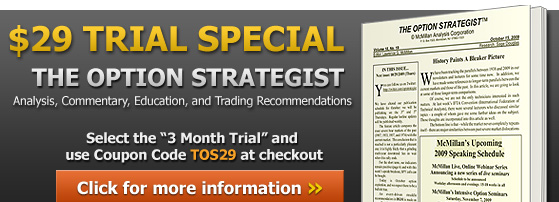
By Lawrence G. McMillan
The new mini options began trading on March 18th. We held off writing about them for a little while so that we could see how volume and open interest were trending. A mini option is for 10 shares of the underlying stock or ETF, rather than 100 shares as is the case with “regular” options. So far, there are mini-options only on five stocks: Amazon (AMZN), Apple (AAPL), Google (GOOG), Gold ETF (GLD), and S&P 500 SPRDs (SPY).
Are these options worth using, or are they just another example of a product that the marketplace doesn’t really need? In this article, we’ll try to answer that question (hint: there’s not a simple “yes” or “no” answer) by looking at volume, pricing, strategy, and other considerations.
Basic Definitions
On March 18th, all of the major option exchanges began trading mini options on three stocks and two ETFs (AAPL, AMZN, GLD, GOOG, and SPY). A mini option is an option on 10 shares of the underlying instrument.
They trade with a slightly different symbol. For the time being, the symbol for the mini-option is merely the regular underlying symbol with “7" at the end (AAPL7, AMZN7, etc.).
The mini options have the ability to trade all of the expiration dates: monthly, weekly, quarterly, and LEAPS. It is unclear if all of these will be listed for all of the underlying instruments.
The obvious attraction of these options to the small retail investor is that they are one-tenth the price of a “regular” stock option. Of course, commission costs are probably not one-tenth as much, since commissions are generally based on how many contracts one trades – not on what those contracts cost. Even if one has a commission rate based on the total dollars in the trade, there is likely to be a minimum commission, and a trade in these mini options would likely be below the minimum.
Mini-futures have been around for quite some time, and there is a large discrepancy in performance for trading systems based on the “big” contracts as opposed to the “mini” contracts. All of that performance difference is due to commissions. The same will be true of the mini-options unless the brokers give special discounts, which – so far – they have not been doing. In effect, the commission rate for a mini option trade is 10 times the rate for a “regular” option trade.
Trading To Date
So far, these options have been a modest success. Here is the trading volume since March 18, comparing the mini options to regular option volume.
| Underlying | Mini Opt Volume | Regular Opt Volume | Pct% |
| AAPL | 85K | 3,664K | 2.3% |
| AMZN | 27K | 415K | 6.5% |
| GLD | 19K | 1,077K | 1.8% |
| GOOG | 13K | 549K | 2.4% |
| SPY | 198K | 1,761K | 11.2% |
SPY seems to be the big winner – both in terms of total volume and in the percentage of regular option volume. That seems a bit strange. It makes some sense to me that small traders would want to utilize mini options in AAPLand GOOG, where the underlyings trade for 450 and 800, roughly. One 3-month, at-the-money “regular” call option on AAPL costs almost $2,400; on GOOG, it costs nearly $3,000.
In our seminars and in our risk management writings in the newsletter, we often encourage speculators to limit each speculative trade to 3% or so of his speculative trading account. Hence, in this newsletter, we often position the trades so that one spends about $1,500 (3% of a theoretical $50,000 speculative account). Moreover, one generally likes to be able to buy more than one option when speculating, so that he can take partial profits along the way.
Clearly, one AAPL or GOOG “regular” option – costing $2,400 or $3,000, respectively – would not fit within those risk parameters. But a mini option would. Instead of buying one 3-month at-the-money “regular” call on AAPL for 24, one could instead buy 6 mini options for 2.40 each, spending $1,440 and staying within the $1,500 risk metric.
For this reason, I think mini options make sense when the underlying is very high-priced, causing a single option to cost more than a retail investor might want to risk in a speculative trade. Hence AAPL, AMZN, and GOOG mini options serve a useful purpose (a 3-month “regular” at-the-money call on AMZN costs $1,500)
However, that is not the case with GLD or SPY. Those options trade at fairly normal prices. A 3-month “regular” call option on either GLD or SPY costs about $400. That should leave enough room to buy multiple contracts with incurring the larger commission rate.
Perhaps those GLD or SPY mini options – which cost about $40 each – would be attractive to very small accounts. In that case, I would say that the mini options are useful if one is truly using risk management techniques on his account. This is often a problem for a very small account – say one with $5,000 or $10,000 in net asset value. An account that small can’t really use the “no more than 3% in any one position” rule, where “regular” options are concerned. But with mini options, he possibly could (whether he would or not is another matter).
Summary
There are benefits to mini options for smaller accounts, especially those who understand and want to implement risk management techniques. However, the drawback is the likely increased commission rate, since commission dollars do not decrease. For those with the discipline to use risk management techniques, the mini options are useful.
The "Mini Options: What's the point?" article was featured in The Option Strategist Newsletter Volume 22, No. 6 (published 3/29/13).
© 2023 The Option Strategist | McMillan Analysis Corporation

